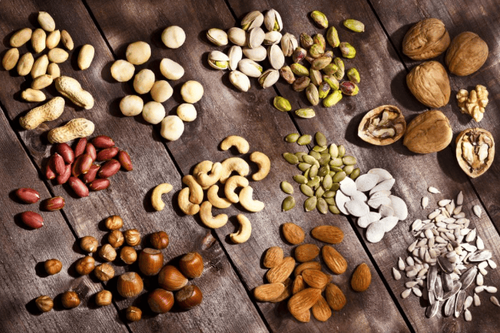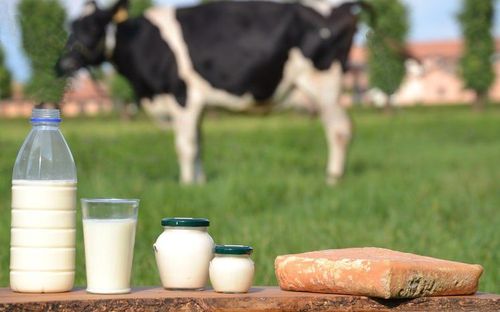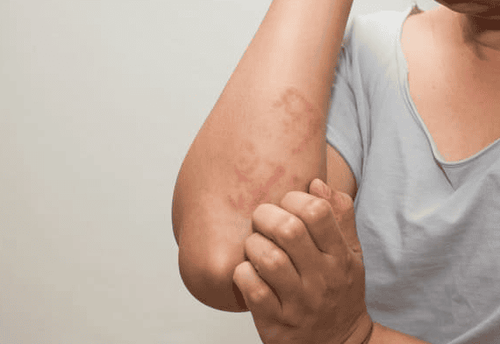This is an automatically translated article.
The article was professionally consulted with Master, Doctor Dang Huy Toan - Department of Pediatrics - Neonatology - Vinmec Nha Trang International General Hospital.Food allergy is a syndrome that has increased rapidly in recent years. Food allergies cause patients to face many troubles because of restrictions in eating and drinking.
1. What is a food allergy?
A food allergy is an allergic reaction by the body's immune system to proteins found in foods. When food enters the digestive system, it is transported into the bloodstream, where it combines with an antibody available on the surface of white blood cells, which ruptures the white blood cell and releases histamine-mediated chemicals. , causing an allergic reaction. Food allergies are easy to occur in people with atopic allergies (such as dermatitis, allergic rhinitis, bronchial asthma...).2. Some risk factors for food allergies
There are many factors that are the risk of food allergies such as:Proteins and molecules do not change when entering the circulatory system; Intestinal immunity and mucosal immunity; Some substances have the ability to increase the permeability of the intestinal mucosa such as aspirin, alcohol, viruses, fungi, and parasites. After eating the allergenic food, if the allergic person works too hard, it can lead to anaphylaxis.

Có nhiều yếu tố có thể nguy cơ gây dị ứng thực phẩm
3. Some foods cause allergies
Of more than 160 potentially allergenic foods, the following 8 major food groups can lead to a food allergy rate of up to 90%.3.1 Cow's milk About 2-3% of children have cow's milk allergy, however 90% of children will resolve on their own by the age of 6.
Cow's milk allergy involves an immune response against one or both of the milk proteins, casein and whey protein. These proteins are also present in the milk of other mammals, so children with a cow's milk allergy are also likely to be allergic to goat or sheep's milk.
Signs of cow's milk protein allergy in children are usually skin manifestations such as red rash, urticaria, dermatitis, eczema; digestive symptoms such as digestive disorders, abdominal pain; respiratory symptoms such as asthma, dyspnea, in the first hour after consuming food.
Severe cases of food allergies can cause anaphylaxis and have a high risk of death. Clinically, cow's milk allergy is often confused with cow's milk intolerance - an inherited disease caused by a lack of the enzyme that digests the sugar lactose. Children with cow's milk allergy are also at risk for allergies to other foods, and allergies to the nose. About 10% of children who are allergic to cow's milk have a reaction to beef.
3.2 Eggs Eggs are the most common food allergy in young children after cow's milk, however, 80% of children have no allergy to eggs by the age of 6. This condition is also rare in adults.
Most of the allergenic proteins are located in the white, the protein in the yolk is less allergenic. The similarity between chicken egg protein and other types of eggs makes people allergic to chicken eggs also allergic to duck eggs, goose eggs, ... however, not allergic to chicken, duck meat.
Eggs are food allergens with skin manifestations such as dermatitis, urticaria and manifestations in the gastrointestinal tract with symptoms such as abdominal pain, vomiting, nausea.
Skin manifestations can appear only a few minutes after using eggs, while gastrointestinal symptoms are very different in time of appearance and severity. Some cases also recorded anaphylaxis and respiratory reactions such as cough, shortness of breath, asthma after eating eggs. If using eggs at high temperature does not reduce the possibility of allergies.
3.3 Seafood Seafood allergy (fish, shrimp, crab, ...) is common in older children and adults, and once allergic, it rarely goes away on its own. Regularly eating seafood will cause allergies.
Common allergy symptoms are mild local reactions in the mouth (such as itchy mouth, itchy throat), skin manifestations (such as rash, urticaria), gastrointestinal. These symptoms usually appear soon after eating. Respiratory manifestations may also be present, severe which can lead to systemic reactions, causing anaphylaxis and life-threatening.
Using food at high temperature does not reduce its allergy, so it is best for people with seafood allergies to limit eating seafood.

Việc thường xuyên ăn hải sản sẽ dễ gây ra dị ứng
The allergenic components of peanuts are storage proteins - a source of nutrients for plant growth, in which, the two most potent allergenic proteins are albumin and vicilin.
Clinical manifestations of peanut allergy may include oral allergy such as itchy mouth, throat or asthma, difficulty breathing, severe possibly anaphylaxis. Of all the foods that cause allergies, peanut allergy is the most severe.
Peanuts can cause a strong allergic reaction at first use. Tingling lips when exposed to peanuts is a warning sign of a possible strong allergic reaction. In very rare cases, people who are allergic to peanuts, even inhalation or minimal skin contact can lead to peanut allergy.
About 80% of children with peanut allergy will have a reaction on the first exposure. People who are allergic to peanuts are also often allergic to other nuts such as chestnuts, almonds, cashews, etc.
The allergenic food threshold for peanuts is about 1 milligram (average 1 peanut has weight of 500 - 1000 mg), which means that 1/1,000 peanuts can trigger an allergic reaction in the patient.
3.5 Nuts Nuts including chestnuts, almonds, cashews, walnuts, pine nuts,... are considered the biggest food allergens, ie only needed in very small amounts. enough to cause a backlash. About 0.5% of people worldwide are allergic to these nuts and the disease rarely goes away on its own.
Children who are allergic to one type of nut will also be allergic to other nuts, or may be cross-allergic to peanuts. Cashew allergy is known to be more severe than peanut allergy.
Nuts are food allergens with clinical symptoms ranging from mild (such as rash around the mouth or body, abdominal pain, nausea, vomiting) to severe can cause difficulty breathing, wheezing, hoarseness voice, or cough due to respiratory allergies. In very severe cases, allergies can cause fainting, anaphylaxis, and death.
Violent reactions to these nuts can be triggered by even a very small amount of food (sometimes just through skin contact or breathing), so allergy sufferers should absolutely avoid these foods. this seed.

Các loại hạt được coi là thực phẩm gây dị ứng lớn nhất
Food allergy symptoms including mild local reactions to the skin, throat and intestines, anaphylaxis reactions are very rare. Wheat allergy is often difficult to distinguish clinically from gluten intolerance or gluten malabsorption syndrome (Celiac disease).
Intolerance to gluten (a protein found in wheat, barley, oats...) causes severe intestinal symptoms, but does not cause intestinal damage like Celiac disease.
3.7 Soybeans Soybeans are the main food allergens in children with eczema, atopic dermatitis. Children usually get rid of allergies after 1-2 years of not using soy. Allergy to soybeans is very rare in adults.
Allergy to food from soybeans can also cause itching and swelling in the mouth and throat, nausea, diarrhea, allergic rhinitis or asthma, hives. In severe cases, people with allergies can lower blood pressure and find it difficult to breathe.
Inhaling soybean meal can also cause respiratory symptoms such as rhinitis, asthma. However, people who are allergic to inhaling pea flour are usually not allergic to foods made from soybeans.
To limit the symptoms caused by food allergies, it is best for people with allergies to avoid using the foods mentioned above.
Please dial HOTLINE for more information or register for an appointment HERE. Download MyVinmec app to make appointments faster and to manage your bookings easily.













